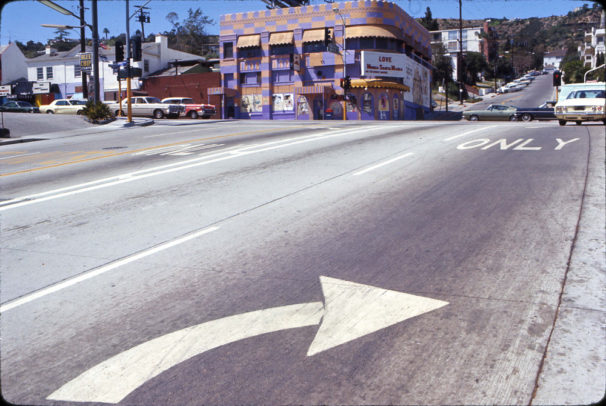
editor’s note: Harvey Kubernik’s new coffeetable tome, 1967: A Complete Rock Music History of the Summer of Love (Sterling), is a both a scholarly examination and a sensuous immersion into the pivotal year in 1960s youth culture through a mosaic of voices. Kirk Silsbee’s sidebars from his essay in the book, excerpted and condensed here, identify the important music venues of the Hollywood Renaissance.
♣ ♣ ♣ ♣
Ed Pearl’s 100-seat Ash Grove on Melrose Avenue in West Hollywood began as a folk-and-coffee garret that became the most important West Coast outpost for folk, blues, ethnic and roots music of all kinds.
Cultural currents swirled at the club in 1967, home base for the gospel-rooted Chambers Brothers and developing blues maven Taj Mahal. The Nitty Gritty Dirt Band opened for country guitar icon Merle Travis, blues powerhouses Muddy Waters and Big Mama Thornton split a bill, as did flat-pick god Doc Watson did with string omnivores Kaleidoscope. Firesign Theatre first tested the limits of comedy, while Spirit gestated. Ethnomusicologist Barry Hansen handled the Ash Grove’s sound, years before he became Dr. Demento.
Actor/director Frank Silvera read Langston Hughes poems and bluegrass duo Vern and Ray opened for Native American singer-songwriter Patrick Sky, while Zydeco accordion hurricane Clifton Chenier made his local debut.
♠ ♠ ♠ ♠
 Doug Weston’s Troubadour on Santa Monica Boulevard was six blocks away from the Ash Grove but more upscale. He was happy to let Pearl book country blues and bluegrass; Weston wanted artists with more commercial potential.
Doug Weston’s Troubadour on Santa Monica Boulevard was six blocks away from the Ash Grove but more upscale. He was happy to let Pearl book country blues and bluegrass; Weston wanted artists with more commercial potential.
Buffalo Springfield and Tim Buckley played some of their first shows here. Offbeat comics like Brother Dave Gardner, Pat Paulson, Dick Davy, Vaughn Meador and Larry Hankin in opened for headliners. Nina Simone cast a spell with “I Loves You Porgy,” the Nitty Gritty Dirt Band brought bluegrass filigree to pop music, Joe & Eddie delivered gospel fervor, Rod McKuen read his greeting card poetry, guitar innovator T-Bone Walker baptized the place with his Texas shuffle blues, Laura Nyro first aired her Bronx soul locally, the Muddy Waters Blues Band landed—twice in two months, the Sunshine Company dished out flower power pop, Bob Lind sang his literate folk ballads, Arlo Guthrie got his first SoCal date, as the searing power and professionalism of the Butterfield Blues Band towered over almost every other band.
♦ ♦ ♦ ♦
The Whisky à Go Go was Hollywood’s central rock venue. In the wake of the Pandora’s Box dust-up that inspired “For What It’s Worth,” the city revoked the Whisky’s dance license. Owner Elmer Valentine reacted by booking black headliners onto the mostly all-white Strip: the Miracles, the Temptations, Gladys Knight and the Pips, Martha and the Vandellas, the Four Tops, the Impressions, Bo Diddley, Hugh Masekela, jazz organist Jimmy Smith and Jackie Wilson. The Doors were installed in May but when Sam and Dave didn’t do well with their week in June, Jimi Hendrix—fresh from his Monterey Pop triumph–was added to the bill. Cream, another power trio, played its most intimate SoCal venue ever in September. By the end of the year the Whisky was the essential launching pad for rock bands.
♥ ♥ ♥ ♥
Kaleidoscope, the floating psychedelic dance club operated by John Hartmann (later to manage Crosby, Stills and Nash), Skip Taylor and Gary Essert (before he founded and helmed Filmex), finally landed on the site of the old Earl Carroll’s, across the street from the Palladium. The rotating stage and 360-degree light show was part of the “total environment” experience. Though it opened with Jefferson Airplane, Canned Heat, Kaleidoscope would burn brightest in 1968.
♣ ♣ ♣ ♣
 New York’s wildly popular Cheetah opened a Santa Monica branch in February in the old Aragon Ballroom. With acres of dance floor, multiple couches, and two four-foot high stages that sat side-by-side, its only competition was Kaleidoscope.
New York’s wildly popular Cheetah opened a Santa Monica branch in February in the old Aragon Ballroom. With acres of dance floor, multiple couches, and two four-foot high stages that sat side-by-side, its only competition was Kaleidoscope.
Cheetah bills included the Young Rascals, Eric Burdon and the Animals, Jefferson Airplane, the Doors, the Byrds, Love, Iron Butterfly, the Grateful Dead, Clear Light, Bo Diddley, Smokestack Lightning, the Seeds, James Brown’s Revue, the Turtles, Captain Beefheart, Larry Williams and Johnny ‘Guitar’ Watson, Big Brother and the Holding Company, Ike & Tina Turner, the Fugs, Quicksilver Messenger Service, Sly and the Family Stone, the Steve Miller Band, Howlin’ Wolf and H.P. Lovecraft. The Electric Flag, Country Joe & the Fish, Pink Floyd, Traffic, Ten Years After and Creedence Clearwater all played their first SoCal bookings at the Cheetah.
Some of the weird scenes inside that pulsating goldmine: Playmate of the Month Angela Dorian was photographed frugging for her September spread, and Strawberry Alarm Clock was filmed for the movie Psych Out. Buffalo Springfield and the Watts 103rd St. Rhythm Band shared an improbable bill. And Arizona transplants the Spiders became the house band before they morphed into Alice Cooper.
♥ ♥ ♥ ♥
‘The Summer of Love Turns 50’ film fest: As a nod to recurring “Summer of Love” fever, the American Cinematheque presents a pop-up 1960s mini film fest.
photo credit: courtesy Henry Diltz-Morrison Hotel Gallery
Kirk Silsbee publishes promiscuously on rock, jazz and culture.

I was so there. I saw Van Morrison (twice), Laura Nyro, and Jackson Browne at the Troubadour. It was such a great scene. I was also at Pandora’s Box. It was a time and a place.